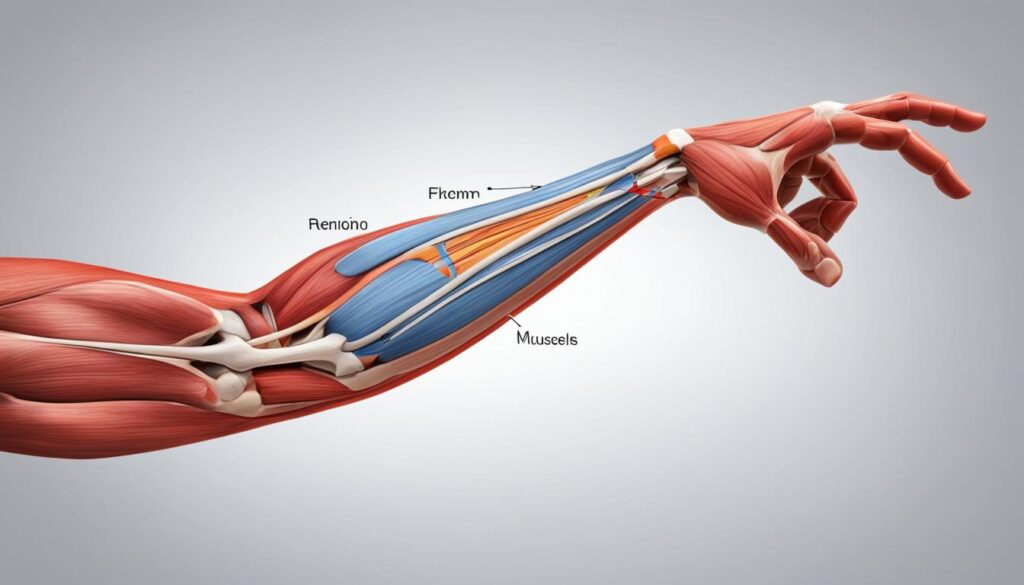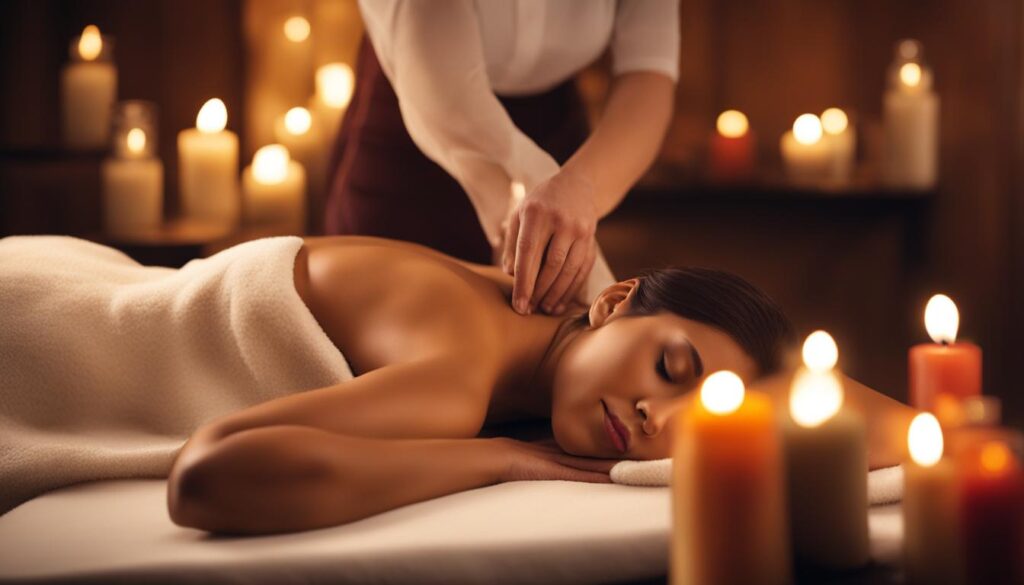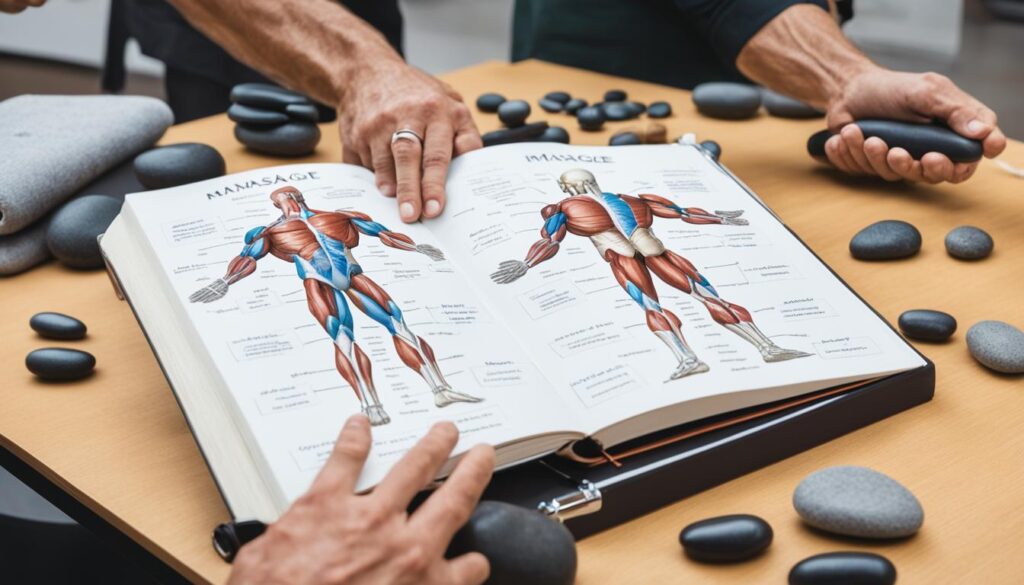If you’ve ever had a massage, you know how relaxing and rejuvenating it can be. But did you know that there’s a science behind this ancient healing art? Massage theory is the foundation that guides massage therapy practices, helping practitioners to understand the techniques and principles that can help promote physical and mental well-being.
In this section, we’ll explore the essentials of massage theory and the benefits it offers. We’ll also discuss the importance of massage education in providing practitioners with the knowledge and skills they need to provide effective therapeutic massage services.
Key Takeaways:
- Massage theory is the foundation that guides massage therapy practices.
- Understanding massage theory can help practitioners provide more effective therapeutic massage services.
- Massage education is essential in providing practitioners with the knowledge and skills they need.
- Massage therapy offers numerous benefits for physical and mental well-being.
- Scientific research supports the efficacy of massage theory and practice.
The Basics of Massage Theory
Massage theory constitutes the foundation of therapeutic massage practices, guiding practitioners on how to deliver effective treatments. At its core, massage theory revolves around the manipulation of soft tissues and muscles to promote relaxation, alleviate pain, and improve overall well-being.
There are several fundamental concepts to massage theory that are critical to understand. One of the most crucial principles is the role of touch and how it affects the body. Through touch, massage therapists can stimulate specific receptors in the skin, which triggers a relaxation response in the central nervous system. This can help to reduce stress and tension in the body, improve circulation, and promote healing.
Another vital aspect of massage theory is understanding the various techniques used in massage therapy. These techniques are designed to target different areas of the body, depending on the client’s needs. Some of the most common techniques include Swedish massage, deep tissue massage, sports massage, and trigger point therapy.
Each technique offers unique benefits and can contribute to overall wellness differently. For instance, Swedish massage emphasizes long, flowing strokes to promote relaxation and improve circulation, while deep tissue massage uses more forceful strokes to target deeper layers of muscle tissue and alleviate chronic pain.
Understanding the principles and techniques of massage theory is crucial in delivering effective therapeutic massage. In the following sections, we will explore the anatomy and physiology of massage, the history of massage, and the various benefits of massage therapy.
Anatomy and Physiology of Massage

The therapeutic benefits of massage are rooted in its impact on the body’s physiological systems. Massage therapy can affect the musculoskeletal, circulatory, and nervous systems, among others.
The musculoskeletal system consists of bones, muscles, tendons, and ligaments. Through the manipulation of soft tissues, massage can help alleviate tension in muscles, increase joint flexibility, and promote overall relaxation.
The circulatory system comprises the heart, blood vessels, and blood. By applying pressure to the skin, massage can increase blood flow and improve circulation, which can reduce inflammation and promote healing.
The nervous system includes the brain, spinal cord, and nerves. Massage can stimulate the parasympathetic nervous system, triggering a relaxation response that can reduce stress, anxiety, and tension.
By understanding the anatomy and physiology of massage, therapists can tailor their techniques to address specific conditions and achieve optimal results.
The Effects of Massage Therapy on the Body’s Systems
| System | Effect of Massage |
|---|---|
| Musculoskeletal | Alleviates muscle tension and stiffness, increases joint flexibility, improves posture, and reduces pain. |
| Circulatory | Increases blood flow, improves lymphatic drainage, reduces swelling, and promotes tissue regeneration. |
| Nervous | Calms the mind, reduces stress and anxiety, enhances mood, and improves sleep. |
Massage therapists can use their knowledge of anatomy and physiology to create customized treatment plans that address each client’s unique needs. By combining theory with practice, massage therapy can deliver a host of benefits for both physical and mental well-being.
The History of Massage
Massage therapy has a rich and fascinating history that stretches back thousands of years. In this section, we will explore some of the key highlights of the history of massage, including its origins and evolution across different cultures. We will also touch upon the role of massage therapy training in preserving and advancing these ancient techniques.
Ancient Origins
The practice of massage can be traced back to ancient civilizations such as China, India, and Egypt. These cultures recognized the healing power of human touch and developed sophisticated techniques for massaging different parts of the body. For example, Chinese practitioners used massage as a therapeutic tool as far back as 2,700 BCE, and Indian Ayurvedic medicine has employed massage therapy for over 5,000 years.
In Egypt, massage was used as a form of physical therapy and played an important role in the treatment of injuries sustained by soldiers and laborers. Egyptian tomb paintings depicting massage techniques date back as far as 2500 BCE, testament to the longevity of this ancient healing art.
East Meets West
Massage therapy continued to evolve over the centuries, with new techniques and practices emerging across different regions and cultures. The ancient Greeks and Romans, for instance, developed their own methods of massage therapy that drew from both Eastern and Western traditions.
In the 19th century, Swedish physiologist Per Henrik Ling developed Swedish massage, which incorporated different techniques such as kneading, vibration, and friction. This new approach emphasized the therapeutic benefits of massage and paved the way for modern massage therapy as we know it today.
The Modern Era
The 20th century saw massage therapy gain widespread popularity and recognition as a legitimate form of healthcare. The founding of the National Certification Board for Therapeutic Massage and Bodywork in 1992 helped to establish standardized training and certification requirements for massage therapists in the US.
Today, massage therapy training programs teach a range of techniques and approaches that draw from both ancient and modern traditions. Massage therapy has also been the subject of scientific research, with studies demonstrating its effectiveness in treating a range of conditions, from chronic pain to anxiety and depression.
Massage therapy has come a long way since its ancient origins, evolving over the centuries into a sophisticated healing art that is both an art form and a science. By learning about the history of massage and the techniques developed throughout the ages, massage therapists can gain a deeper understanding of the art they practice and the benefits it can offer to clients today.
Research and Evidence on Massage Theory

Massage therapy is a popular alternative therapy used to treat various conditions. Over the years, there has been a growing body of massage research aimed at exploring its effectiveness as a therapeutic intervention. Support for the efficacy of massage theory is evident across numerous studies and findings.
For instance, a recent study published in the International Journal of Therapeutic Massage and Bodywork found that therapeutic massage improved flexibility, strength, and balance in older adults. Another study by the National Center for Complementary and Integrative Health showed that massage therapy can effectively reduce chronic low back pain.
Further evidence of the benefits of therapeutic massage can be found in massage articles. These articles often showcase new findings, advances in massage research, and unique therapeutic techniques.
“Massage therapists are increasingly educated, and the general public’s demand for massage therapy has also increased. However, more high-quality research is needed to support the efficacy of massage therapy in treating various conditions.”
It’s important to note that all massage research should be approached with a critical eye, as not all studies are created equal. Nevertheless, the growing body of literature on the subject points to the potential for massage therapy to provide a safe and effective complement to conventional medical treatments.
Benefits of Massage Therapy

Massage therapy offers numerous benefits for both physical and mental well-being. Regular therapeutic massage has been shown to:
- Alleviate stress: Massage therapy can reduce levels of cortisol, a hormone associated with stress, and increase levels of serotonin and dopamine, which promote relaxation and feelings of well-being.
- Reduce muscle tension: Massage therapy can release knots and tension in muscles, improving flexibility and mobility, and reducing the risk of injury.
- Improve circulation: Massage therapy can stimulate blood and lymphatic flow, facilitating the delivery of oxygen and nutrients to tissues and organs, and helping to remove waste products and toxins.
- Promote relaxation: Massage therapy can activate the parasympathetic nervous system, which counteracts the effects of the sympathetic nervous system (“fight or flight” response), inducing a state of deep relaxation.
Other benefits of massage therapy may include improved sleep, reduced headaches, relief from chronic pain, improved immune function, and more. With so many benefits, it’s no wonder that massage therapy is becoming an increasingly popular form of complementary healthcare.
“Massage is not just a luxury, it’s a way to a healthier, happier life.”
Studies on Massage Benefits
Research has shown that massage therapy can have significant benefits for a variety of conditions and populations. For example:
| Condition/Population | Benefit |
|---|---|
| Chronic low back pain | Massage therapy can reduce pain and improve function. |
| Cancer patients | Massage therapy can reduce symptoms such as pain, nausea, and fatigue and improve quality of life. |
| Depressed pregnant women | Massage therapy can reduce symptoms of depression and improve mood. |
These are just a few examples of the many studies that have demonstrated the effectiveness of massage therapy in improving health and well-being. If you are interested in learning more about the benefits of massage therapy, speak to a qualified massage therapist or healthcare provider.
Massage Education and Training

Formal education and training in massage therapy is crucial for a successful career in the field. There are different paths to becoming a certified massage therapist, including vocational schools, community colleges, or private institutions offering massage therapy programs.
The Key Components of a Comprehensive Massage Therapy Program
A comprehensive massage therapy program covers a broad range of topics and skills to prepare students for the variety of challenges they will face in their work. Some of the key components of a massage therapy program include:
| Topic | Description |
|---|---|
| Anatomy and Physiology | Learning about the body’s systems, structures, and functions is essential to understanding the effects of massage therapy on the body. |
| Massage Techniques | Hands-on training in various techniques, such as Swedish, deep tissue, sports massage, and others, is necessary to develop the skills to treat clients effectively. |
| Business and Ethics | Students should be familiarized with the laws, regulations, and ethical considerations applicable to the profession, as well as basic business practices, including marketing and scheduling. |
| Internship or Clinic Hours | Practical experience is critical to developing the skills and confidence necessary to be a successful massage therapist. Many programs offer internship or clinic hours to give students hands-on experience working with real clients. |
While massage education and training can be time-intensive and involve significant financial investment, it is essential for developing the skills and knowledge required to be a qualified and professional massage therapist.
Enhancing Massage Techniques with Theory
Massage therapy is an ancient practice that involves the manipulation of soft tissues and muscles in the body. While there are many techniques used in massage therapy, a solid understanding of massage theory is essential to enhance the effectiveness of these techniques and achieve optimal results.
Massage theory informs the application of different strokes, pressure, and movements used in therapeutic massage to address specific issues. It guides practitioners in tailoring their approach to each client, ensuring that they provide the best possible care.
One example of how theory enhances massage techniques is the use of Swedish massage. This technique involves long strokes, kneading, and friction, performed in a particular sequence to relax muscles and increase circulation. By understanding the principles behind this technique, practitioners can modify their approach to meet the unique needs of each client and achieve the desired results.
Other popular massage techniques, such as deep tissue massage and sports massage, also rely on massage theory to achieve their intended effects. Deep tissue massage utilizes slow, deep strokes, and pressure to target specific muscle groups, while sports massage incorporates stretching and other techniques to improve athletic performance and prevent injuries.
By incorporating massage theory into their practice, massage therapists can ensure that their techniques are not only effective but also safe and appropriate for each client’s needs. Additionally, a deeper understanding of massage theory can help therapists recognize and address contraindications and avoid potential adverse effects of massage therapy.
Conclusion
Massage theory is an essential component of therapeutic massage practices. By providing a comprehensive understanding of the principles and techniques that guide massage therapy, it enables practitioners to optimize their techniques and deliver maximum health and wellness benefits to their clients.
Throughout this article, we have explored the basics of massage theory, its historical context, the anatomy and physiology that underpins it, and the various benefits it offers. We have also highlighted the importance of education and training in becoming a skilled massage therapist, as well as how theory can enhance the effectiveness of different massage techniques.
By incorporating massage theory into their practices, massage therapists can better understand the mechanisms by which massage works, how it affects the body, and how to tailor treatments to meet the unique needs of each client. This knowledge can lead to improved outcomes, increased client satisfaction, and a deeper appreciation for the art and science of massage therapy.
Whether you are a seasoned practitioner or just starting your journey in massage therapy, taking the time to learn about massage theory can have a profound impact on your skills, techniques, and overall success. So why not start exploring the world of massage theory today and uncover the countless benefits it has to offer?
Thank you for reading this article and we hope it has been informative in enhancing your understanding of massage theory and the many benefits it provides.
Remember, by continually expanding your knowledge and skills as a massage therapist, you can help more people achieve optimal health and wellness, and ultimately, make a positive impact on the world around you.
So go forth, explore, and continue to grow as a massage therapist!
FAQ
What is massage theory?
Massage theory refers to the foundational concepts and principles that guide the practice of therapeutic massage. It encompasses various techniques, such as Swedish massage, deep tissue massage, and sports massage, and emphasizes the physiological and psychological effects of these techniques on the body.
What are the benefits of massage therapy?
Massage therapy offers a wide range of benefits, including stress and anxiety reduction, muscle relaxation, improved circulation, pain relief, and enhanced overall well-being. It can also help improve flexibility, boost immune function, and promote better sleep.
Is massage therapy a regulated profession?
Yes, massage therapy is a regulated profession in many countries and states. Practitioners are required to complete formal education and training programs, pass licensing exams, and adhere to professional codes of ethics to ensure the safety and quality of client care.
How long does it take to become a certified massage therapist?
The length of time to become a certified massage therapist varies depending on the educational program and the individual’s commitment to their studies. Typically, it takes several months to two years to complete the necessary training, including classroom instruction, hands-on practice, and clinical experience.
Can anyone receive a massage, or are there certain conditions that may prevent someone from getting a massage?
While massage therapy is generally safe for most individuals, there are certain conditions and contraindications that may restrict or require modifications in the massage treatment. These may include infectious skin conditions, fever, severe illness, acute injuries, certain medical conditions, or pregnancy. It is important to consult with a qualified massage therapist to ensure a safe and appropriate treatment plan.
Does massage therapy have any scientific evidence to support its effectiveness?
Yes, there is a growing body of scientific research that supports the effectiveness of massage therapy for various conditions. Studies have shown positive outcomes in reducing pain, improving mobility, alleviating symptoms of anxiety and depression, and promoting overall well-being. However, further research is still needed to explore the full potential and mechanisms of massage therapy.
Can massage therapy be used as a standalone treatment or is it often combined with other therapies?
Massage therapy can be used as a standalone treatment or in combination with other therapeutic interventions, depending on the individual’s needs and goals. It is often integrated into holistic healthcare approaches, working in conjunction with chiropractic care, physical therapy, acupuncture, and other complementary therapies to optimize outcomes.
Are there any specific areas of the body that massage therapy can target?
Massage therapy can target various areas of the body, including the neck, shoulders, back, arms, hands, legs, and feet. Different techniques and modalities are employed to address specific issues, such as tension headaches, back pain, muscle strains, or joint stiffness, providing localized relief and improving overall muscle balance and function.
Can people with no prior experience learn and practice massage therapy?
Yes, individuals with no prior experience can learn and practice massage therapy. Many accredited massage therapy schools offer comprehensive programs that include both theoretical and practical training. However, it is important to have a genuine interest in the field, good interpersonal skills, and a compassionate nature to excel in this profession.

